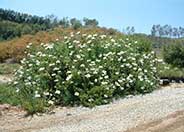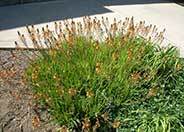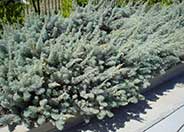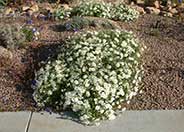
Common name:Pygmy Date Palm, Roebelin Palm
Botanical name:Phoenix roebelenii
This tree will grow to about 10' tall and has dark green, spiny petiole foliage. It does well in full sun to heavy shade; it likes moderate to heavy irrigation, but can take periods of dryness.

Common name:Matilija Poppy
Botanical name:Romneya coulteri
Crowned by white poppies, this high-impact, spreading, gray green perennial stands statuesque at 8' tall. It is best used where its scale and habit will not overpower neighboring plants. It requires no summer water and thrives on dry alluvial slopes.
Maintenance Tips
Romneya coulteri is a large, herbaceous, California native perennial that is grown for its attractive gray-green foliage and showy, white poppy flowers that bear resemblance to fried eggs. It can grow up to about 8' tall and wide but can spread up to 20’ away by underground runners known as rhizomes. Despite its large size, it is relatively easy to maintain. Flowering begins in the spring and lasts until late summer. In the fall, the foliage will start to wither, which is when it is best to cut all the stalks down to about 6". Once they are removed, you can leave this plant alone to regrow back in a matter of a couple of months.
Common name:Mexican Palo Verde, Jerusalem Thorn
Botanical name:Parkinsonia aculeata
The Mexican Palo Verde has prickly stems. This tree is very fast growing with sparse foliage and very long narrow leaves. Yellow flowers with orange red throats bloom sporadically. It is very messy, thorny, weedy and short-lived. This tree is usually found on limestone soils in areas with moisture but is strongly drought tolerant. It can withstand saline conditions. It can be cold or drought deciduous. It is beautiful in form being light and airy looking, with green bark.

Common name:Dwarf Orange Bulbine
Botanical name:Bulbine frutescens 'Hallmark'
This bulbine is the compact variation of yellow bulbine. This plant grows to about 1' tall by 1'-2' wide. Orange flowers bloom almost all year long. Plants stay evergreen, but will freeze to the ground in the event of serious frost. However, frost- damaged plants will regrow in spring. Delicate coppery orange flowers with fluffy yellow centers are on tall spikes that rise above the foliage. This selection is free flowering in spring, summer and fall.

Common name:Catmint
Botanical name:Nepeta X faassenii
Nepeta faassenii makes soft, gray green, undulating mounds that are 1.5' high when blooming. The small leaves are attractive to cats. This perennial has lavender blue flowers in late spring and early summer.

Common name:Damianita
Botanical name:Chrysactinia mexicana
This mounding groundcover grows slowly to 2' tall and wide. Golden yellow daisylike flowers appear in spring and fall. The yellow flowers agains the aromatic dark green foliage makes it a colorful accent. Good for courtyards. Resembles turpentine bush but has longer bloom period. Needs good drainage. Periodic pruning willinduce flowering. Accepts reflected sun. It is a slow grower so be patient. Native to western Texas and Mexico.
Maintenance Tips
Chrysactinia mexicana is a small, evergreen perennial with fragrant foliage and very showy flowers that emerge in spring. This is a very drought-tolerant plant that will look and perform its best in full sun and well-drained soil. It is considered pest and disease-free and gets all of the nutrients it needs in just about any soil condition. It only grows 1-2' tall and wide, so it can be used in just about any space in any sized garden without having to prune to maintain the size. After the blooming ends, the plant will benefit from some pruning to cut off the spent flowers and to improve the shape. If the blooms start to slow down in the summer, this plant will benefit from some supplemental water. The additional water can keep the plant blooming until the fall.
Common name:Powis Castle Artemisia
Botanical name:Artemisia 'Powis Castle'
This mounding shrub reaches 3' high and up to 5' wide with fine silver foliage.

Common name:Blackfoot Daisy
Botanical name:Melampodium leucanthum
Small mounding perennial grows quickly to 1' x 2'. White daisylike flowers with yellow centers cover the plant nearly year-round The leaves are narrow and gray-green. Accepts full sun or partial shade but blooms better in the sun. Bright and colorful groundcover. Plant in well-drained soil. Native to the southwest U.S. and Mexico.
Maintenance Tips
Melampodium leucanthum or the Blackfoot Daisy, is a small herbaceous perennial that reaches 12 – 18" tall and wide. It is very drought and heat-tolerant and requires very little maintenance to look and perform its best. Once the plant is established, it requires very little water, but it does tend to have a much longer blooming cycle if it is offered supplemental water during the spring and summer. It is very attractive to birds, butterflies, and bees and is usually pest-free. As an herbaceous perennial, it can be attractive to aphids and other soft-bodied insects that can damage the foliage. Instead of using pesticides to control these pests, it would be better to use a hard jet of water or even bring in ladybugs to treat the infestation. That will ensure the beneficial insects and birds can continue to enjoy the flowers.Designer: Susan Triindle
Photographer: GardenSoft